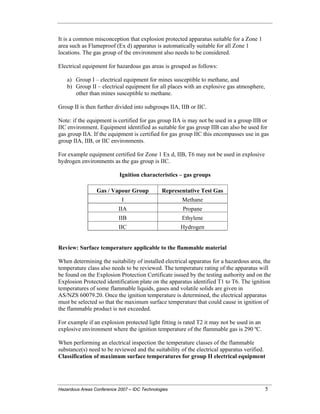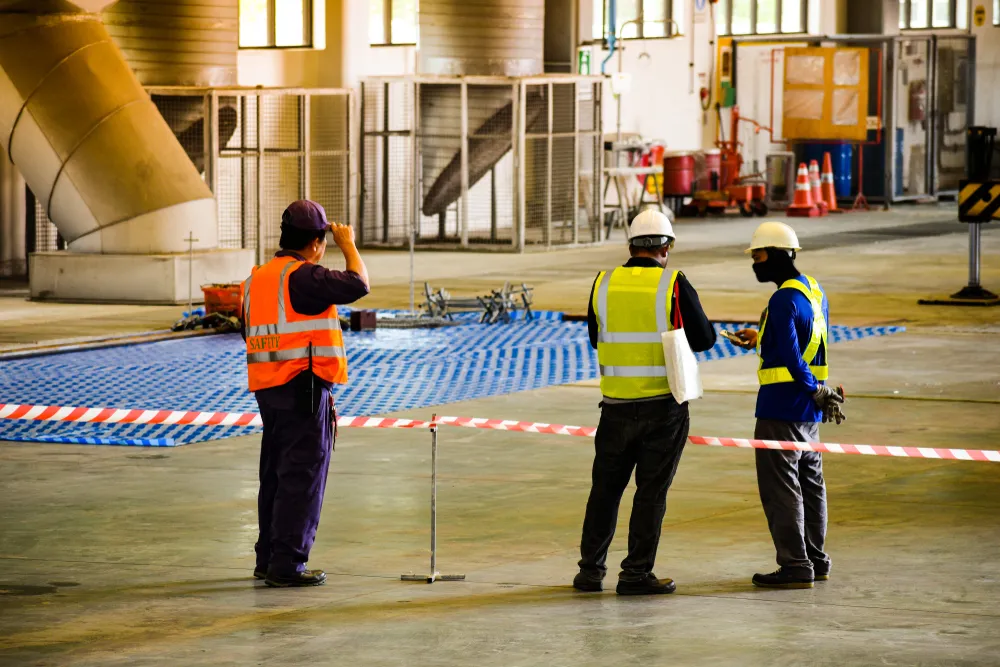Fascination About Roar Solutions
Fascination About Roar Solutions
Blog Article
Some Known Incorrect Statements About Roar Solutions
Table of ContentsThe Ultimate Guide To Roar SolutionsSome Of Roar SolutionsThe Ultimate Guide To Roar Solutions
In such an ambience a fire or explosion is feasible when 3 fundamental problems are met. This is frequently referred to as the "hazardous location" or "burning" triangle. In order to safeguard installations from a potential surge an approach of analysing and identifying a possibly dangerous area is called for. The objective of this is to make sure the appropriate selection and installment of devices to inevitably stop an explosion and to make sure safety of life.
(https://pinshape.com/users/7197164-roarsolutions#prints-tab-open)
No tools should be mounted where the surface temperature of the devices is higher than the ignition temperature of the offered danger. Below are some usual dust hazardous and their minimum ignition temperature. Coal Dust 380C 225C Polythene 420C (thaws) Methyl Cellulose 420C 320C Starch 460C 435C Flour 490C 340C Sugar 490C 460C Grain Dirt 510C 300C Phenolic Material 530C > 450C Aluminium 590C > 450C PVC 700C > 450C Residue 810C 570C The possibility of the danger existing in a focus high enough to cause an ignition will vary from place to area.
In order to identify this threat a setup is split into areas of threat relying on the quantity of time the harmful exists. These locations are referred to as Zones. For gases and vapours and dirts and fibers there are three areas. Zone 0 Zone 20 A harmful atmosphere is very most likely to be present and might be existing for extended periods of time (> 1000 hours each year) or perhaps constantly Zone 1 Zone 21 A hazardous ambience is feasible however not likely to be present for long durations of time (> 10 450 C [842 F] A classification of T6 suggests the minimal ignition temperature is > 85 C [185 F] Harmful area electrical tools perhaps developed for usage in higher ambient temperature levels. This would certainly suggested on the rating plate e.g. EExe II C T3 Ta + 60C( This means at 60C ambient T3 will certainly not be surpassed) T1 T1, T2, T3, T4, T5, T6 T2 T2, T3, T4, T5, T6 T3 T3, T4, T5, T6 T4 T4, T5, T6 T5 T5, T6 T6 T6 A T Class ranking of T1 indicates the maximum surface area temperature created by the instrument at 40 C is 450 C. Thinking the connected T Course and Temperature ranking for the devices are appropriate for the location, you can constantly use an instrument with a much more stringent Department rating than required for the location. There isn't a clear solution to this question however. It really does depend upon the kind of devices and what repairs require to be lugged out. Devices with particular examination procedures that can not be performed in the field in order to achieve/maintain 3rd party rating. Need to come back to the factory if it is before the equipment's solution. Field Repair Service By Authorised Employee: Complex screening might not be called for however certain treatments might need to be complied with in order for the tools to preserve its 3rd party ranking. Authorised workers have to be utilized to carry out the work properly Repair service must be a like for like replacement. New component need to be considered as a direct replacement requiring no unique screening of the equipment after the repair is full. Each tool with a hazardous rating must be reviewed individually. These are described at a high level below, however, for even more in-depth info, please refer straight to the guidelines.
Excitement About Roar Solutions
The equipment register is a thorough data source of equipment documents that includes a minimum collection of fields to recognize each product's location, technological parameters, Ex-spouse classification, age, and ecological information. This details is important for tracking and taking care of the equipment properly within hazardous areas. On the other hand, for periodic or RBI sampling assessments, the grade will certainly be a mix of In-depth and Close evaluations. The proportion of Detailed to Shut inspections will be established by the Equipment Danger, which is examined based on ignition risk (the likelihood of a resource of ignition versus the probability of a flammable ambience )and the unsafe area classification
( Area 0, 1, or 2). This variation will certainly additionally influence the resourcing demands for job preparation. Once Whole lots are specified, you can develop sampling strategies based on the example dimension of each Lot, which refers to the number of arbitrary equipment products to be examined. To establish the required sample dimension, two aspects need to be assessed: the dimension of the Whole lot and the group of assessment, which shows the degree of initiative that should be applied( decreased, typical, or raised )to the examination of the Whole lot. By incorporating the classification of assessment with the Lot size, you can then develop the suitable being rejected requirements for an example, implying the permitted number of defective things located within that example. For even more information on this process, please refer to the Energy Institute Guidelines. The IEC 60079 conventional suggests that the optimum period between evaluations need to not go beyond 3 years. EEHA inspections will certainly additionally be performed outside of RBI campaigns as part of set up upkeep and tools overhauls or repairs. These examinations can be attributed towards the RBI sample dimensions within the affected Great deals. EEHA inspections are conducted to determine faults in electric devices. A weighted scoring system is essential, as a solitary tool might have numerous faults, each with varying degrees of ignition threat. If the consolidated score of both inspections is much less than twice the mistake score, the Whole lot is regarded acceptable. If the Great deal is still considered unacceptable, it needs to undergo a complete assessment or justification, which might activate stricter assessment protocols. Accepted Whole lot: The reasons for Visit Your URL any type of faults are determined. If a common failure setting is discovered, added equipment may call for evaluation and fixing. Mistakes are identified by extent( Security, Honesty, House cleaning ), ensuring that urgent issues are analyzed and addressed quickly to mitigate any type of effect on security or operations. The EEHA data source should track and tape the lifecycle of faults together with the rehabilitative activities taken. Executing a durable Risk-Based Examination( RBI )strategy is vital for making certain compliance and safety and security in handling Electric Devices in Hazardous Areas( EEHA) (Roar Training Solutions). Automated Fault Scoring and Lifecycle Management: Easily handle mistakes and track their lifecycle to improve evaluation precision. The introduction of this support for risk-based examination further strengthens Inspectivity's position as a best-in-class option for governing conformity, along with for any asset-centric evaluation usage case. If you are interested in learning much more, we invite you to request a demonstration and find exactly how our service can transform your EEHA management processes.
The Basic Principles Of Roar Solutions

In regards to eruptive threat, a dangerous area is an environment in which an eruptive ambience is present (or may be expected to be existing) in quantities that require special preventative measures for the building, installation and use tools. eeha. In this short article we explore the obstacles dealt with in the office, the danger control steps, and the required expertises to function securely
It issues of contemporary life that we make, store or manage a range of gases or fluids that are deemed combustible, and a range of dirts that are deemed flammable. These substances can, in specific conditions, develop eruptive atmospheres and these can have significant and heartbreaking consequences. A lot of us recognize with the fire triangular get rid of any among the 3 aspects and the fire can not take place, however what does this mean in the context of harmful locations? When breaking this down into its simplest terms it is essentially: a mix of a certain amount of launch or leakage of a particular material or material, combining with ambient oxygen, and the existence of a source of ignition.
In many instances, we can do little regarding the degrees of oxygen airborne, however we can have substantial influence on sources of ignition, as an example electrical equipment. Dangerous locations are documented on the harmful location category illustration and are identified on-site by the triangular "EX" indication. Right here, amongst other crucial info, areas are split right into 3 types depending upon the danger, the chance and period that an eruptive ambience will certainly exist; Zone 0 or 20 is deemed the most unsafe and Area 2 or 22 is deemed the least.
Report this page